Z-dependence
______
Nov 1, 2007
First look at chi vs z in my fitting:
chisq = new TH3F("chisq","Chisquare Dist (log10)",100,-5,3,20,0,200,250,1.495,3.995);
...
chisq->Fill(TMath::Log10(chi),z,ot);
...
int zbin
for (zbin=1;zbin<20;zbin++) {
chisq->GetYaxis()->SetRange(zbin,zbin);
mm = chisq->Project3D("zx");
mm->SetName(Form("zz%d",zbin));
((TH2D*) mm)->ProfileY();
}
Using the GG = -65 data from day 22, I found only the following z bins used: 2,5,8,11,14-15,17-18. I combined the latter 2
chisq->GetYaxis()->SetRange(14,15);
mm = chisq->Project3D("zx");
mm->SetName("zz14a")
((TH2D*) mm)->ProfileY();
chisq->GetYaxis()->SetRange(17,18);
mm = chisq->Project3D("zx");
mm->SetName("zz17a")
((TH2D*) mm)->ProfileY();
And plotted these 6 zbins:
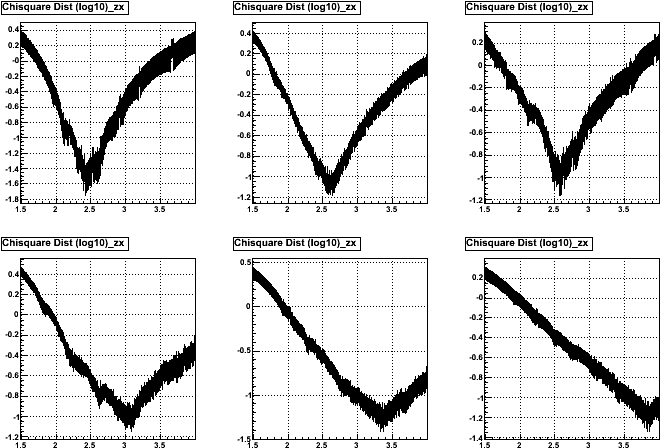
There's an obvious z-dependence here :-( Larger z lasers (closer to endcap) want a larger omegatau value. Argh!
For further info, here's the data for GG = -165V:
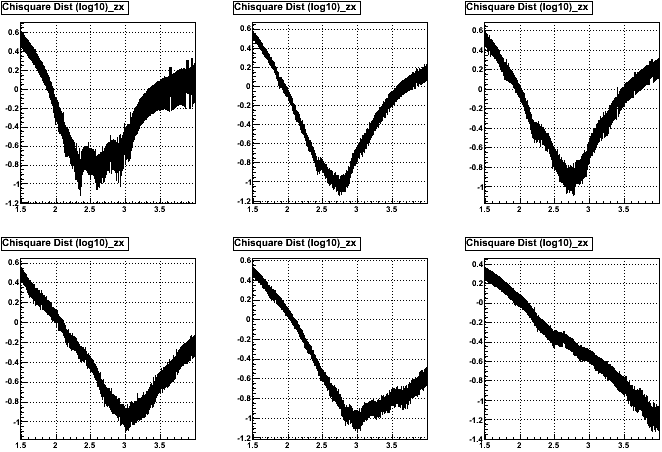
which is on the whole rather similar, and then the extra resistor run:
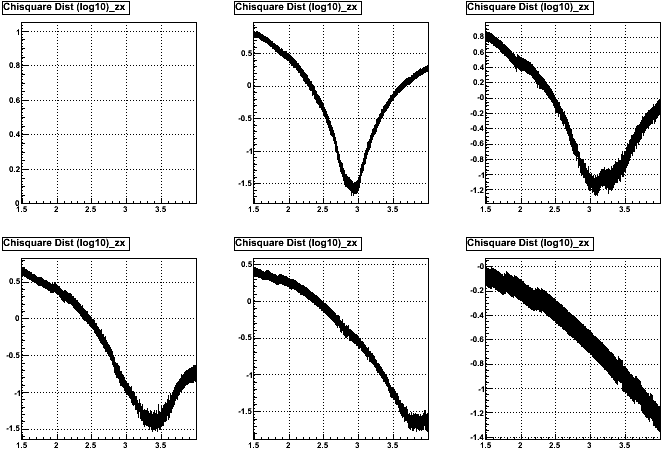
where the first z bin wasn't used (Z=15cm lasers). In addition to the over-riding thrust to higher omegatau in the extra resistor run, the loss of the first z bin only further contributes to not wanting a low omegatau value.
So we have TWO PROBLEMS: z-dependence of fits, and GG runs not matching the extra resistor run
What to do!?!?!
Note that this z-dependence contrast a little bit with the Old Work study I did back in 2004 which showed a rather mild, if any, z-dependence. But note that I did not use the lasers closest to the endcap in that study, and I recall claiming at the time that the distortion correction did not work properly at large z, small r.....which is exactly what I'm seeing here!!! And the next-to-last laser in that study did show perhaps an indication of a rise (though not quite as strongly as I'm seeing here, as it wanted ~3.3 and I want ~3.8 for this laser).
One thing I probably didn't do then that I've done now is to subtract off the z value needed to get the central membrane strips to be at z=0. I could try adding that back in and see what happens...
Looking at day 63 data and adding back in z += 6.54.
Hmm....it helped ....but not a huge amount:
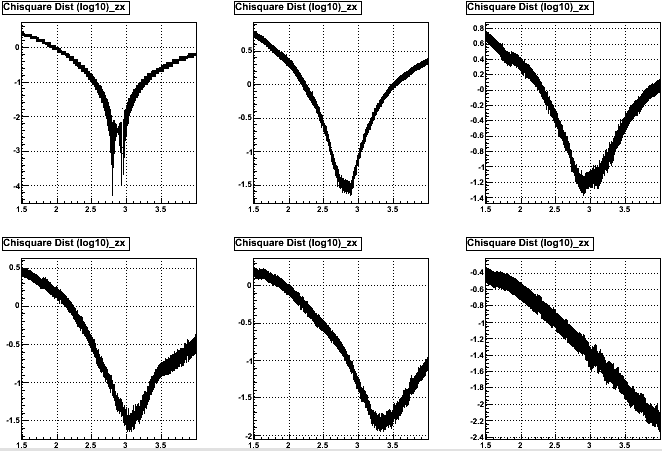
Note that the z=15 laser snuck in because it got moves up above 20 with my positive z shift. I will note that the last two (closest to endcap) got appreciably lower in omegatau. The ones closer to the endcap are more affected because that's where the distortion map changes more rapidly, since the E-field distortions are strongest near the endcap. So the data far from the endcap has lesser sensitivity. Note that now I'm getting ~3.3 at the next-to-last-in-z laser, just as I did in the Old Work study! That's good confirmation I'm not doing anything radically different from that time!
Well that invites trying an even larger shift....let's try 15.0 cm:
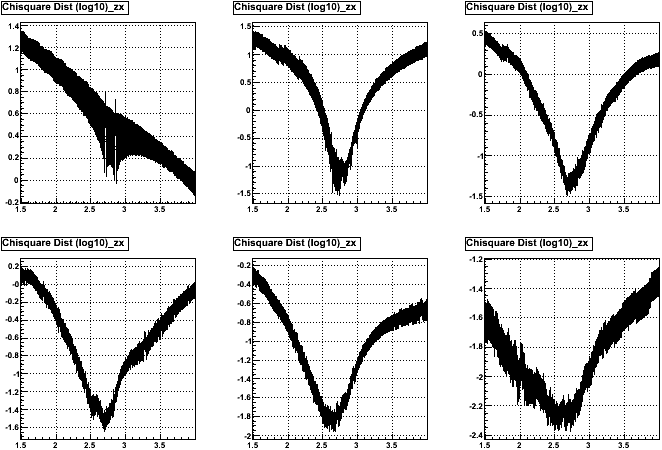
!!!! THAT WORKED!!! Everything now dips down at about the same location, with the exception of that oddball laser at the first z bin, but that's why I was excluding it in the first place.
Let's think about what this means....the distortion map appears to fit the data better if the data is shifted 15cm towards the endcap.....
WAIT! Maybe I was getting the T0 wrong....if the T0 was shifted the other way, then the CM hits at negative z may really have been from the positive z lasers!!!! Doh!
I can't find any documentation to confirm this, but that makes some sense....the lasers are supposed to be ~30cm apart, and given a 210cm long volume, that should mean 30...180 for the six bundles on each raft (for that I did find documentation, in the NIM paper on it). So the first laser should be at ~30, not 15 as I've been finding. But the solution is simple since it's just a simple shift and I haven't corrected the data: just add the amount I subtracted off, plus the amount I should add. In the case of the day 63 data, this is 6.54+7.00 + 13.54. In the day 22 data, this is 6.45 + 6.91 = 13.36.
So after adjust the adderr parameters (reducing them, yay!) I get the z-dependence for the day 63 data as follows:
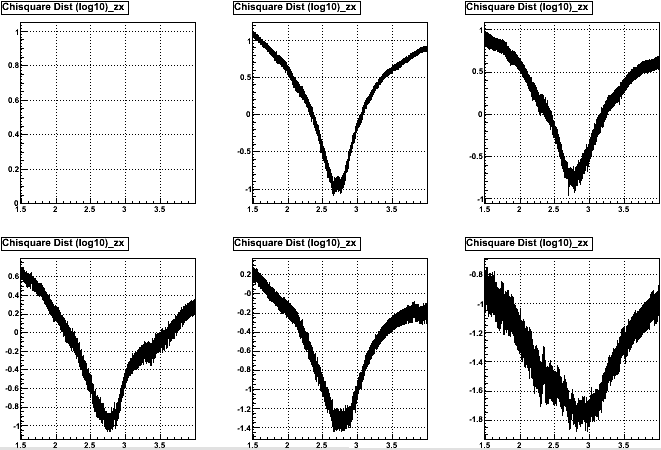
I guess it looks fairly reasonable. So it's clear that my earlier study was flawed from using the wrong z values!!!
chisq = new TH3F("chisq","Chisquare Dist (log10)",100,-5,3,6,15,195,250,1.495,3.995);
...
int zbin
for (zbin=1;zbin<7;zbin++) {
chisq->GetYaxis()->SetRange(zbin,zbin);
mm = chisq->Project3D("zx");
mm->SetName(Form("zz%d",zbin));
((TH2D*) mm)->ProfileY();
}
c1->Clear()
c1->Divide(3,2)
c1->cd(1)
zz1_pfy.Draw()
c1->cd(2)
zz2_pfy.Draw()
c1->cd(3)
zz3_pfy.Draw()
c1->cd(4)
zz4_pfy.Draw()
c1->cd(5)
zz5_pfy.Draw()
c1->cd(6)
zz6_pfy.Draw()
That works for all the runs. Here's the GG = -65V run:
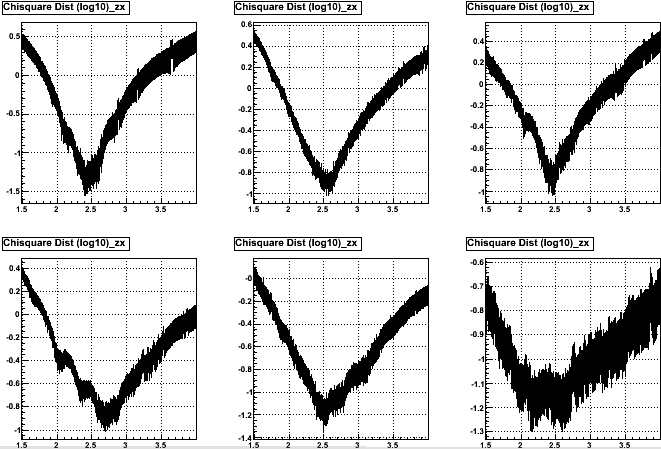
Good. Z-dependence story is over! Let's move on...